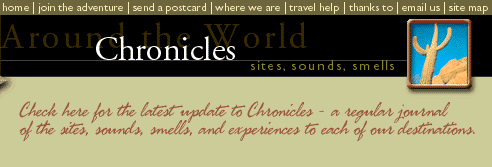Nov.
20-25, 1998 Edinburgh, ScotlandAs sometimes happens while traveling
in Europe, a rugby match has turned the relatively routine task of finding accommodations
for the evening into something of a challenge. The home team in Edinburgh is in a BIG
match tomorrow with the visiting reigning world champions - South Africa. It seems that
almost the entire country has traveled to the capital to witness the expected trouncing
first hand. Laura and I had little interest in heading for the match, just matching our
head with a pillow. Laura's unusually energetic mood this evening proves to be a big asset
in finally securing lodging, as she calls and runs around while I babysit the packs.
We find a great little B&B, just 15 minutes walk from the station.
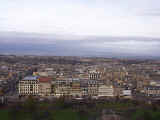 As the morning greets us, we take advantage of
the fact that the majority of the townsfolk are either cheering at the stadium, or glued
to a TV in their local pub, as a great opportunity to explore the city in relative
peacefulness. It is said that the pride of the all the Scots is manifested in this, the
majestic city of Edinburgh. And from looking around, it seems the Scotsmen do have
something to be proud of. From the tall gray-stone Georgian terraces standing at stately
attention, to the sprinkling of medieval buildings planted solidly on their original
foundations, the city's variety of architecture makes it one of the most handsome capital
cities in all of Europe.
As the morning greets us, we take advantage of
the fact that the majority of the townsfolk are either cheering at the stadium, or glued
to a TV in their local pub, as a great opportunity to explore the city in relative
peacefulness. It is said that the pride of the all the Scots is manifested in this, the
majestic city of Edinburgh. And from looking around, it seems the Scotsmen do have
something to be proud of. From the tall gray-stone Georgian terraces standing at stately
attention, to the sprinkling of medieval buildings planted solidly on their original
foundations, the city's variety of architecture makes it one of the most handsome capital
cities in all of Europe.
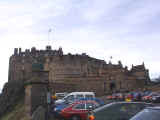 One of these medieval buildings, the one that absolutely
dominates the skyline, is our first stop of the day. It is the city's most prominent
example of its pride and beauty - Edinburgh Castle. Perched atop the highest point within
sight, that of the volcanic projection known as Castle Rock, the massive structure has
always been at the attention-getting center of things. Thus, it has seen more than its
fair share of battles and destruction as its ownership went from one warring faction to
the next. Because various parts of the castle have been demolished, rebuilt, and/or
further fortified, it is a hodgepodge of architectural styles. Each stage of its history
and the construction that came with it, reflect the castle's myriad of different uses as
well as the rulers that decreed those uses. Laura and I relive the centuries of history,
with the help of an audio player and headphones, as we weave in and out of the castle's
many chambers, halls, and dungeons, letting ourselves get lost in the legends.
One of these medieval buildings, the one that absolutely
dominates the skyline, is our first stop of the day. It is the city's most prominent
example of its pride and beauty - Edinburgh Castle. Perched atop the highest point within
sight, that of the volcanic projection known as Castle Rock, the massive structure has
always been at the attention-getting center of things. Thus, it has seen more than its
fair share of battles and destruction as its ownership went from one warring faction to
the next. Because various parts of the castle have been demolished, rebuilt, and/or
further fortified, it is a hodgepodge of architectural styles. Each stage of its history
and the construction that came with it, reflect the castle's myriad of different uses as
well as the rulers that decreed those uses. Laura and I relive the centuries of history,
with the help of an audio player and headphones, as we weave in and out of the castle's
many chambers, halls, and dungeons, letting ourselves get lost in the legends.
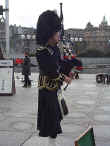 Now, from the kingly castle, to the Royal Mile.
We bid farewell to Edinburgh Castle and make our way on the street running down the hill
into the Old Town. This strip, known as the Royal Mile, was the main artery of the city
for over six centuries. It took the completion of the elegant New Town in the 18th
century, to detract from its popularity. With this addition, Edinburgh was split into the
Old Town, encompassing the Royal Mile running down the hill from the castle and the
medieval alleys and tenements surrounding it, and the New Town, with its grand terraces
and crescents of Prince Street, and the pubs and restaurants of Rose Street.
Now, from the kingly castle, to the Royal Mile.
We bid farewell to Edinburgh Castle and make our way on the street running down the hill
into the Old Town. This strip, known as the Royal Mile, was the main artery of the city
for over six centuries. It took the completion of the elegant New Town in the 18th
century, to detract from its popularity. With this addition, Edinburgh was split into the
Old Town, encompassing the Royal Mile running down the hill from the castle and the
medieval alleys and tenements surrounding it, and the New Town, with its grand terraces
and crescents of Prince Street, and the pubs and restaurants of Rose Street.
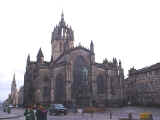 We
casually strolled down the cobblestone thoroughfare, lined with churches, museums,
other grand institutions, including my favorite, the Royal Mile Whiskies store. Inside the
walls of this small, inconspicuous shop are bottles of some of the finest Scotch Whiskey
in the world. Boasting many brands simply not available anywhere else, it is a popular
stop for even those who have more of an appreciation for the heritage of this elixir than
the taste.
We
casually strolled down the cobblestone thoroughfare, lined with churches, museums,
other grand institutions, including my favorite, the Royal Mile Whiskies store. Inside the
walls of this small, inconspicuous shop are bottles of some of the finest Scotch Whiskey
in the world. Boasting many brands simply not available anywhere else, it is a popular
stop for even those who have more of an appreciation for the heritage of this elixir than
the taste.
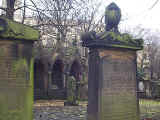 Occasionally, we would wander down into the honeycomb of steep
and winding alleyways known as 'closes'. These once plague infested, trash ridden rows of
multi-story slums, are now nicely restored and tidily preserved window shopping utopias.
This, the Old Town is far refined from the days of the past when garbage and waste raining
down from windows above, and refuse stagnating in open sewers below, gave the city the
undesirable nickname of 'Auld Reekie' - loosely translated: 'Stinkyville'. Not only that,
but before long this most morally upright city developed a seamier side, with an estimated
200 brothels in business in the early Victorian period. Add to that rampant crime, and
widespread disease amoung the 30,000 residents, and you have, overall, not a pleasant
place to call home in the middle 1800's.
Occasionally, we would wander down into the honeycomb of steep
and winding alleyways known as 'closes'. These once plague infested, trash ridden rows of
multi-story slums, are now nicely restored and tidily preserved window shopping utopias.
This, the Old Town is far refined from the days of the past when garbage and waste raining
down from windows above, and refuse stagnating in open sewers below, gave the city the
undesirable nickname of 'Auld Reekie' - loosely translated: 'Stinkyville'. Not only that,
but before long this most morally upright city developed a seamier side, with an estimated
200 brothels in business in the early Victorian period. Add to that rampant crime, and
widespread disease amoung the 30,000 residents, and you have, overall, not a pleasant
place to call home in the middle 1800's.
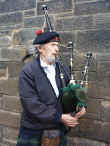 In
sharp contrast, the stately Georgian townhomes and sprawling crescents of the New Town
gave the city of Edinburgh two faces - the opulence of the New Town and the destitution of
the Old Town. In fact, it was this sharp contrast that inspired Robert Louis Stevenson's
narrative of opposites, The Strange Case of Dr. Jekyll and Mr. Hyde. Like the
story, it took seeing the two sides of the same city, to have a true appreciation of what
was hidden beneath the surface. Fortunately for us, it wasn't a group of snaggle-toothed,
hunch-backed, schizophrenic killers, but a wonderfully warm and friendly bevy of cheerful
Scots, that we discovered and now have found memories of, on 'the other side' of
Edinburgh.
In
sharp contrast, the stately Georgian townhomes and sprawling crescents of the New Town
gave the city of Edinburgh two faces - the opulence of the New Town and the destitution of
the Old Town. In fact, it was this sharp contrast that inspired Robert Louis Stevenson's
narrative of opposites, The Strange Case of Dr. Jekyll and Mr. Hyde. Like the
story, it took seeing the two sides of the same city, to have a true appreciation of what
was hidden beneath the surface. Fortunately for us, it wasn't a group of snaggle-toothed,
hunch-backed, schizophrenic killers, but a wonderfully warm and friendly bevy of cheerful
Scots, that we discovered and now have found memories of, on 'the other side' of
Edinburgh.

